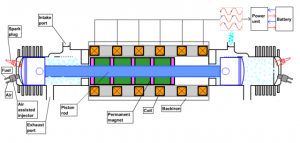Oct
2
The Free Piston Engine Is Back In the News
October 2, 2008 | 12 Comments
The free piston engine an offshoot of the “boxer engine” of BMW and Subaru fame is an opposed piston arrangement without connecting rods to a crankshaft. Instead a magnet is part of the connection between the pistons, which are simply connected straight across from each other.
That absence of rotating mass, angular torque use of the energy from the gas expansion, pistons sliding against the cylinder walls and other parasitic losses allow much higher efficiencies to be gathered. The use of magnets on the connection and coils surrounding them creates a form of an alternator to harness the fuel’s reactive power. Dr. Peter Van Blarigan at Sandia National Laboratory (SNL) carried out a series of single-shot combustion experiments on the rapid compression expansion machine to simulate the free-piston motion. Using HCCI combustion, the experiments proved to have the thermal efficiency of 56% and low NOx and HC emissions. That’s very impressive, some 2 and ½ times the efficiency of rotating shaft outputs for harness the power output. The new descriptive name is “Free Piston Linear Alternator,” (FPLA).
The late news comes from the acceptance of a paper by Qingfeng Li, Jin Xiao, and Zhen Huang at Shanghai Jiaotong University, Shanghai China now web published by the American Chemical Society. In the paper the researchers have run simulations across a range of engine layouts from single piston, the double piston as noted above and four piston models. The paper arrives at a conclusion that the opposed two piston arrangement is most efficient.
The other conclusions of note are that over the course of the piston’s travel the speed can be nearly constant, and upon reversal just before maximum stroke the acceleration would be at least 3 times that of a piston connected to a crankshaft. That effect reduces the time at highest compression so reducing the compression build up of heat. That not generating of heat adds to efficiency and reduces the temperature so reducing undesired combustion byproducts and in turn allowing a higher compression ratio adding still more efficiency.
The peak of the stroke is the ideal time to ignite a fuel, so avoiding blow back during the rise to peak stroke, and assuring the full fuel energy is expended in the draw back from the peak. Additionally using a lean fuel mixture with high compression ratios adds to the thermal efficiency.
The combustion time is very short in high compression ratios with the maximum temperatures and pressures lower than a crank engine so reducing the fuel mix to temperature driven emission creation. Proper control can make a very emission friendly engine.
The Shanghai teams work seems to be based on extensive development by Peter Van Blarigan who reported for a Peer Review back in 2002. Van Blarigan’s work sought to prove out an ideal OTTO cycle constant volume combustion, at very high compression ratios with low emissions with a mechanically simple device offering constant power out with electrical output.
But . . .
As you can well imagine these are going to shake and vibrate madly. Mr. Van Blarigan has, it seems, to have let go of the project and left his supporting employer, Sandia Labs. The controls to manage compression, ignition, fuel and oxygen are under study around the world, including Australia, Sweden and China. To get to current oscillations of 60 hertz alternating the engine would need to run at 3600 cycles per minute which poses some interesting sensor, processing, control mechanism and fueling issues that are yet to be worked out.
On first look it’s an elegant idea that does demand development. As computational power speeds up, sensors improve and control devices gain speed and fine tuning the operation of this design should become practical. That would leave the shake and vibration matter to solve. Other layouts, four pistons, and other ideas may prove more fruitful.
The FPLA comes up every couple years, and this year it’s a welcome addition with the news that the Chinese are working to build a functioning design. I wish them great good fortune, these seemingly small problems are quite difficult to solve.
Comments
12 Comments so far




Mor info and price.
price
Promising beginning.
how would transmit the power obtained?
Power transmit on wire by electric potential.
Awesome post. I so good to see someone taking the time to share this information
Thanks for posting. Good to see that not everyone is using RSS feeds to build their blogs 😉
I’ve just started off a blog, the knowledge you give on this site has aided me extremely. Thank you for all your time & work.
Intriguing post. I have been searching for some good resources for solar panels and discovered your blog. Planning to bookmark this one!
Awesome post. I so good to see someone taking the time to share this information
A lot of infos about free-piston engines can be found on my homepage
run this piston on hho. How much current can one piston produce?